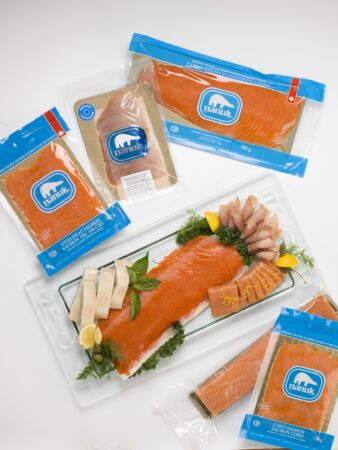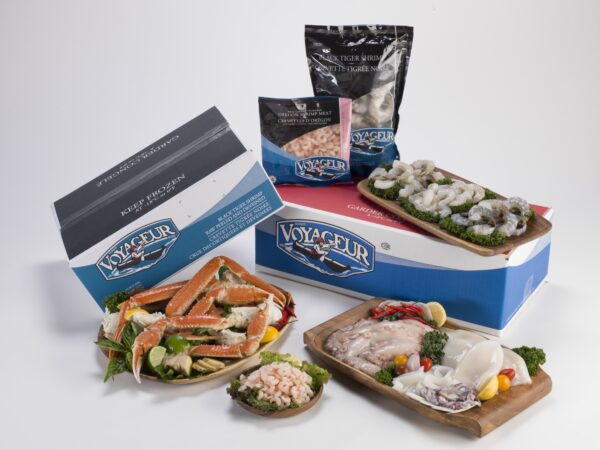
Oceanfood Sales brings global seafood brands to Canada
By Mark Cardwell
Food In Canada Seafood British Columbia Oceanfood SalesRevealing the legacy, brands, and flavours that position Oceanfood Sales for success
 Oceanfood Sales’ premium house brand Nanuk offers cold smoked seafood, which is processed at a company facility on Mitchell Island, B.C. Photos © Oceanfood Sales
Oceanfood Sales’ premium house brand Nanuk offers cold smoked seafood, which is processed at a company facility on Mitchell Island, B.C. Photos © Oceanfood Sales Rob Graham makes no bones about the quality of seafood products his family’s company has been making and importing for more than 50 years.
“Everything we sell is top tier. We only deal in the best stuff,” said Graham, chief operating officer of Oceanfood Sales. “Our products are for people who understand quality and know what they want.”
Headquartered in Vancouver’s Downtown Eastside, Oceanfood Sales makes two house brands and imports another half-dozen brands from partner companies around the world. Most of those frozen seafood products are destined for the foodservice market, as well as to major food retailers across Canada.
Graham said Oceanfood Sales’ premium house brand—Nanuk, the Inuit word for polar bear—was originally developed for the foodservice industry. But its popularity among chefs led to it becoming a retail item.
The brand is produced at Oceanfood Sales’ smoking facility on Mitchell Island in the Fraser River. More than 100 people work at the 30,000-sf facility, where wild and farmed salmon, steelhead, trout, mackerel, albacore tuna, yellow fin tuna and black cod are filleted, salted, smoked, and packaged into 18 items across the Nanuk brand’s three product lines: cold smoked, hot smoked, and filets, portions and loins.
“Smoked salmon is a luxury item that is meant to taste good,” said Graham, who runs the company with his sister Louise, and vice-president Ted Kim. “My job is to find the best salmon, the best cod, the best everything.”

Product line
The company’s second house brand, which is called Voyageur, is a co-packed line developed exclusively for Canadian restaurateurs, chefs, and suppliers. It features a dozen raw and cooked tuna, shrimp, salmon, ground fish, crab, squid, and scallop products from around the world. Imported seafood brands that Oceanfood Sales buys and markets across Canada include King & Prince, Mrs. Friday’s, Pride of Alaska, Coldwater Prawns, Dutch Harbour, Orca Bay Foods, and Upper Crust Enterprises.
Graham said strong and growing demand for his company’s products across Canada has led to the opening of sales and distribution offices in Calgary, Toronto, and Montreal.
A heritage of quality
The company’s quest for quality began with Graham’s father John, who moved to B.C. from Ontario in the late 1950s with the intention of studying medicine at the University of British Columbia. Instead he got a job on a salmon fishing boat in Namu, a now-abandoned fishing port on the B.C. coast.
Namu was then a hub in a flourishing West Coast commercial fishing industry. It was notably home to a large cannery owned by B.C. Packers, Canada’s largest fish processing company until the 1990s, when the fishery floundered.
“Dad got a job with B.C. Packers and spent several years there in processing and sales,” said Graham. “That’s where he learned the seafood business, which is really a primary resource industry like mining or logging.”
Graham was just five when his father struck out on his own and founded Oceanfood Sales in 1970.
“He started buying and selling troll-caught B.C. salmon to smokers in Europe, predominantly France and Denmark,” said Graham.
He said five kinds of wild salmon were then being harvested by the millions using hooks or nets along Canada’s West Coast, including Coho, chum, pink, spring and sockeye, the most prized species.
“Troll salmon are the best quality because they’re caught using lines and hooks and can be bled and dressed on the boat,” said Graham. “You can’t do that with scoop nets because they are too many fish. Plus, with nets you get other problems like bruising.”
In addition to exporting salmon, Graham said his father also began importing truckloads of breaded shrimp from Fish King in Los Angeles and wild frozen shrimp from Alabama and Louisiana.
“He was one the first people in Canada to do that,” said Graham. “He was like a trader, buying and selling salmon and shrimp to distributors and wholesalers.”
He said his father’s friends and clients in Europe later sold him on the idea of getting into the salmon smoking business.
“Dad bought a small plant right downtown, not far from where our offices are now,” said Graham. Both he and his sister started working in the plant in the 1980s while studying, respectively, marketing and accounting at the British Columbia Institute of Technology.
Both siblings joined their parents in the family firm after graduating.
“It was an easy transition because we grew up in the business,” he said. “It was the main topic of conversation around the family table. Dad would often bring friends and clients home for supper. You learned a lot just by osmosis.”
Graham said he also often accompanied his father, who is now retired, on his frequent trips around the world in search of new seafood products and partners.
“My father is a very engaging person and was an excellent salesman who was well respected,” said Graham. “My sister and I were lucky to have him as a mentor.”
Adapting to demand
Graham said the decision to build a state-of-the-art smoking facility 20 years ago on Mitchell Island on the Fraser River, which separates the cities of Vancouver and Richmond, was the key to unlocking the growth and development of the company’s top-selling Nanuk brand.
“We were turning people away before and we couldn’t pursue the customers we wanted,” said Graham.
He said the new smoking facility was designed “like a circle that’s always moving forward” for the manufacture of products and to eliminate the possibility of cross contamination.
Raw materials—much of it now aquaculture salmon works—enter the one-floor facility on one end and are put into a holding freezer before being racked and moved to a thawing room.
Once thawed, fish are processed through fillet, pin bone and brining machines before being smoked, sliced, vacuum packed, frozen, and then put into boxes for pick up by third-party reefer carriers.
Graham said he and his sister are in the plant almost daily, though they no longer pitch in to help on the single-day shift or with clean up.
“Louise and I have built a strong team from the foundation we inherited and we continue to grow the business together with our employees, which are our most valuable asset,” he said.
Graham added he and his sister also regularly visit trade shows and other smoking facilities to stay abreast of the latest technologies.
“The seafood business is constantly changing and evolving,” said Graham. “We continue to strive to make the best possible product by adapting to new ways of doing and to our customers wants and needs.”
This article was originally published in the November/December 2023 issue of Food in Canada.
Print this page